
Just across the Firth of Forth from Scotland’s busy capital, the kingdom of Fife is another world
[caption id="FifeKingdomofNooksandCrannies_Feature" align="aligncenter" width="1024"]
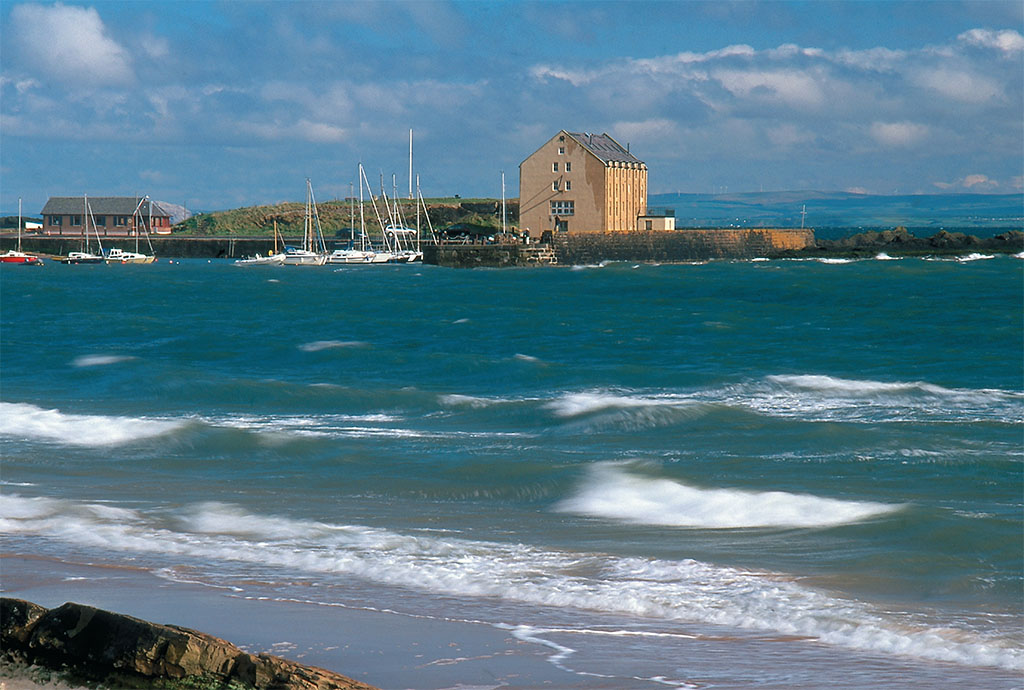
JIM HARGAN
As my wife and I drove into the seaside village of Elie, our home in Fife for a week, I was braced for what we might find. One of a dozen seaside settlements on a section of coast known as the East Neuk (meaning “nook,” but pronounced nyuke), Elie had promised to be pretty—but British beach towns are sometimes over-loved, and Elie was, after all, only 35 miles from Edinburgh’s western suburbs. I need not have worried. Elie wasn’t just pretty, it was flawless, chock-a-block with lovely old stone cottages, shops surrounding a square and a spectacular waterside with a stone quay, cliffs and a golden sand beach. It had no modern fringe, hardly any modern buildings and its shops were the sort that make a British village one of the most pleasant places to live: a greengrocer, a butcher, a baker, a newsstand, a farm shop, a tearoom and two fine old pubs, one on the quay and the other facing a 19th-century golf course. Indeed, our approach to Fife had been very promising. Fife is a 500 square mile county—small by Scottish standards—occupying a peninsula just across the Firth of Forth (“Bay of the River Forth”) from Edinburgh. We had decided to gas up and eat lunch while still near the airport, on the Edinburgh side of the firth, and this led us to blunder happily into Queensferry.
[caption id="FifeKingdomofNooksandCrannies_img1" align="aligncenter" width="1024"]
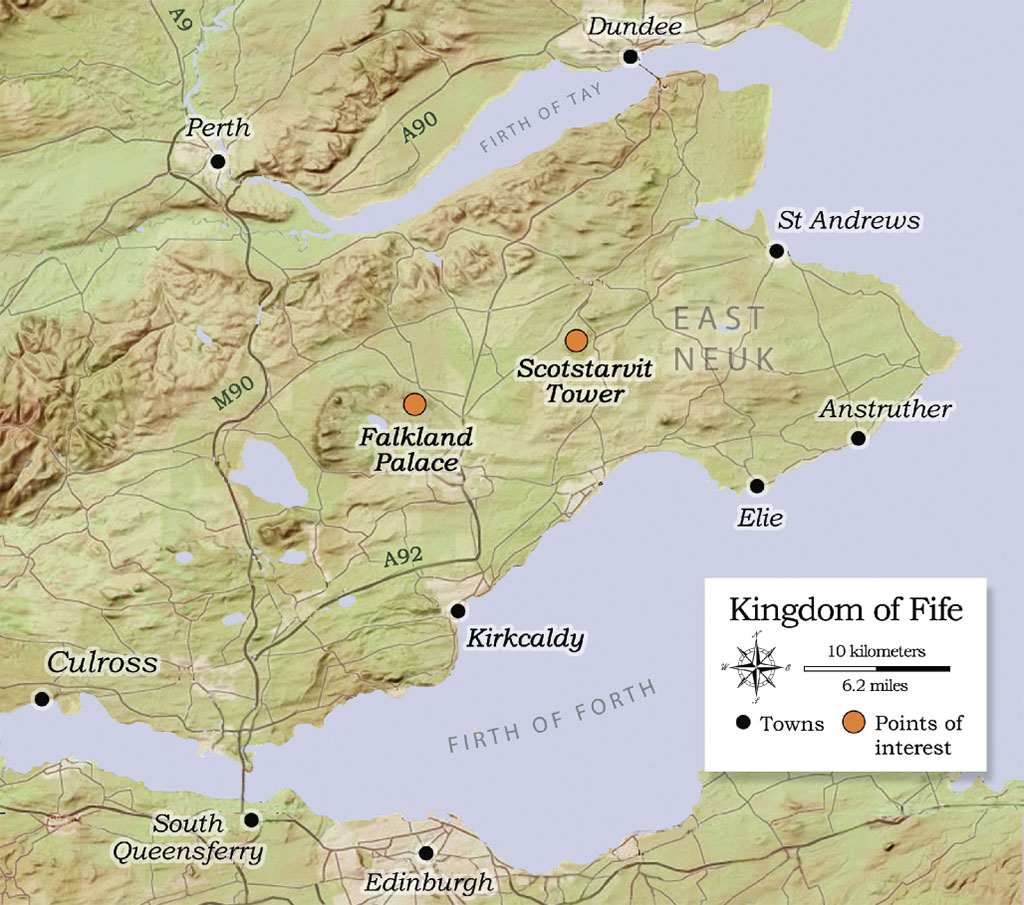
GREGORY PROCH
Once a royal burgh, Queensferry is named for Queen Margaret, the wife of the Malcolm who Shakespeare sent fleeing from Macbeth. Its attractive stone-built town center curves above an impressive harbor, now quiet although it was a busy ferry port until the 1960s. At its eastern end we found the Hawes Inn, site of the title event of Robert Louis Stevenson’s Kidnapped, where we enjoyed local cask ale with our lunch. From its window we could admire the Forth Railway Bridge soaring overhead; built in 1890 out of massive steel tubes painted red, it’s one of the most visually striking bridges anywhere in the world. At the other end of this small town looms the Forth Road Bridge, a graceful suspension structure built in 1964. The view from the town’s medieval stone quay takes in both bridges, and forms a wonderful contrast with these pillars of modern engineering. Try finding that six miles from Heathrow!
Once we settled into our home base at Elie, we had a chance to explore. Our stone-built cottage overlooked the sea, and the golden sand beach started 100 feet from our door. Outside our kitchen windows, low cliffs rose up above the harbor, which curved around to a long, sand spit where colorful little boats had been dragged upon dunes. At low tide the harbor became hard, level sand, and a mixed group of teenagers got up an informal game of cricket on this fine surface. Cottages were a wondrous hodge-podge of old red sandstone, limestone as golden as any in the Cotswolds and a variety of white and colored paint, with every historic period well represented. I assume that sea bathers would become thick in the high summer season, but we were there in May, and tourists such as us were in third place behind locals and golfers.
Shadowy tales from the past, many of doubtful pedigree, cling to Fife like so many old spider webs. We found a great store of them in Elie, carefully preserved on informational plaques scattered helpfully about the village. The townhouse kitty-cornered across from us, a simple 19th-century structure with a curiously elaborate doorway, was said to be the remains of a castle. An odd cliff-top tower was correctly identified as an 18th-century folly, but then associated with a Godiva-esque tale of the supposed noble beauty who ordered its construction. On a headland to the village’s south we found a modest ruin with a plaque that declared it to be a Dark Age hermitage—but the plaque was the only thing to distinguish it from the many, nearly identical, small stone barns nearby. This headland, known as Earlsferry, was said to be named for Earl Mac-duff’s flight from Macbeth at this very spot, an incident from William Shakespeare’s almost completely fictional play.
VISITING FIFE
GETTING THERE. Edinburgh Airport (EDI), a little over six miles from Queensferry and the bridge to Fife, has a daily nonstop flight from Newark, NJ (EWR), and, of course, plenty of one-stop flights via London. There is a wide choice of auto rentals.
Trains go to Fife but do not reach any point near the East Neuk; just as well, as they don’t go to the airport either. If you do wish to travel by train, the closest stations to the airport are South Gyle (SGR), 3.5 miles away and Dalmeny (DAM), 6.7 miles away and just outside Queensferry. If you are traveling to or from points south on express trains, you will arrive/depart from either Waverley Station (EDB) in Edinburgh’s congested center, or from Haymarket (HYM), one stop west.
FURTHER INFORMATION. Queensferry, once an independent town, is now governed by Edinburgh and has no website of its own; it’s well covered, however, by standard regional sites such as Edinburgh University’s Gazetteer of Scotland (www.geo.ed.ac.uk/scotgaz) and the excellent independent site Undiscovered Scotland (www.undiscoveredscotland.co.uk).
To ride across the Firth of Forth Railway Bridge get a ticket from North Queensferry (NQU) to Dalmeny (DAM); the five minute ride (one way) costs about £3 return. Dalmeny station sits 150 feet above Queensferry on a steep hillside; the walk around and down is almost a mile.
Fife’s official website, run by its council, is www.visitfife.com. St. Andrews has several dedicated websites: www.standrews.co.uk gives a general introduction and links to all the others, including www.standrewsgolf.org, the official (and very detailed) golf course guide. Another site, www.eastneukwide.co.uk, is dedicated to the East Neuk. For Scotstarvit, Falkland Palace and Culross search the National Trust of Scotland pages at www.nts.org.uk.
[caption id="FifeKingdomofNooksandCrannies_img2" align="aligncenter" width="948"]

JIM HARGAN
[caption id="FifeKingdomofNooksandCrannies_img3" align="aligncenter" width="1024"]
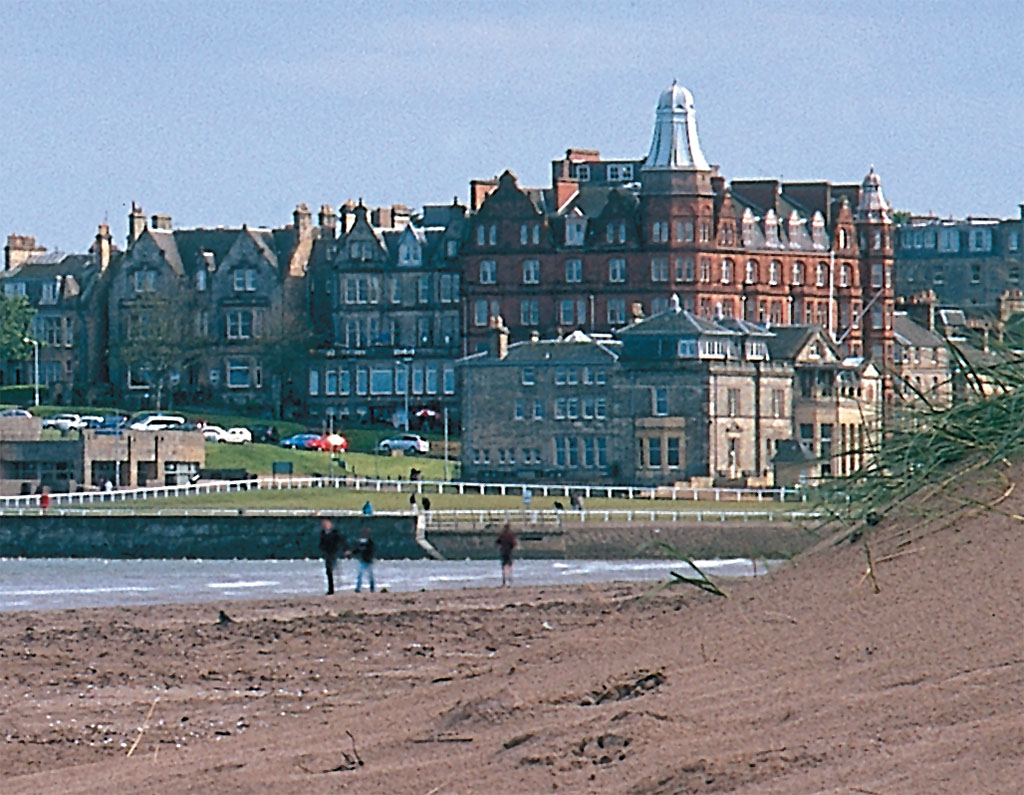
JIM HARGAN
Such stories serve to give meaning to the landscape in a way that bald facts cannot. There had actually been a castle, now long gone, on the spot of that odd doorway. Even if Shakespeare’s account of Macbeth was pure historic guff, the Macduffs were real enough and noblemen of Fife, and perhaps even of the mysterious Pictish kingdom of Fib that was its predecessor. Stone barns stand abandoned on fields that, many centuries earlier, had been holy sites. And not all these holy sites were Christian in their ultimate origins; legends cling to spots where Queen-of-the-May celebrations had Christianized pagan sacrificial ceremonies.
Elie is only one of several villages along The East Neuk. This rich and beautiful fringe takes up the middle third of Fife’s 90 mile coast, facing across the Firth of Forth toward Edinburgh, then jogging up to confront the North Sea at the university town of St. Andrews, world home of golf.
Scotland’s great contribution to international sports evolved in late medieval times on grass-covered sand dunes, known as “links.” St. Andrews’ links are especially good, a 1¾ mile long peninsula made up of old dunes that stretch fan-like northward from the town. Each dune-line marks out a golf course; the middle dune holds The Old Course, first recorded in 1552 and said to be the oldest in the world. All the dune-courses converge on the northern edge of town, at the Royal and Ancient Golf Club, a massive Victorian pile, and the British Golf Museum, whose bunkerlike appearance forms a visual pun. The courses are owned by the town and are all public, as is the beach—wide, sandy and easily reached from a gravel road that runs along its entire length.
Apart from golf, St. Andrews possesses a variety of historic sites that add up to a worthwhile day. The town stretches eastward from its links for nearly a mile, centering on a wide market square; it’s handsome and old, and has lots of shops and bad parking. At its far end sits its castle, in very ruinous condition, and its cathedral, in even worse shape, having been destroyed by rioting Presbyterians in 1559. The town’s tiny old stone quay lies behind the cathedral, very quaint and hidden. Its university was founded in 1410, and two of its quads are open to the public: St. Mary’s (1537) and St. Salvator’s (1450), the latter reached from the waterfront via the unfortunately named Butts Wynd (a wynd being an alley, and a butt being an oversized barrel).
However fine the golf, history and shopping in St. Andrews, the scenic glory of the East Neuk lies south of it, in the villages that stretch along the Firth of Forth. The first town, nine miles south of St. Andrews, is Crail, where charming stone cottages crowd around a market place, then step down to a tiny stone harbor on cobbled lanes. Another four miles along comes the largest of the lot, the grown-together villages of Cellardyke, Anstruther Easter and Anstruther Wester. Anstruther Easter has the large stone harbor most sought-out by tourists, happy with yachts and fishing boats, and lined with shops and brightly painted stone cottages, while Cellardyke has its own stone quay, thick with terraced stone buildings. Another mile takes you to Pittenweem, and then to St. Monans, each a small fishing village grouped around a stone harbor, isolated from its neighbors by farms and fields. Elie, with its scenic variety and eccentric history, is next up in 2.5 miles.
The East Neuk ends at another merged village, Lundin Links with Drummochy, Upper Largo and Lower Largo. We spent a few lazy hours poking around there, and were amazed at what we found. Upper Largo sits a bit inland on two hills; its pub perches atop one, and gives a view across to its church, on the other. When we sought out the church we found it elevated on its own island, surrounded by cottages; inside the churchyard, we found a Pictish stone slab of red sandstone, carved with a Celtic cross on one side and eroded figures of men and horses on the other. A few blocks down on the waterside, at Lower Largo, we stumbled upon a lifesize statue of Alexander Selkirk, whose unique adventures were fictionalized in Robinson Crusoe, set in the second story wall of the cottage where he was born. At the adjacent village of Drummochy we found a narrow tidal gorge framed by an arching Victorian railroad bridge flying high above—possibly the most scenic, and definitely the smallest, quay in the East Neuk.
[caption id="FifeKingdomofNooksandCrannies_img4" align="aligncenter" width="1024"]

JIM HARGAN
[caption id="FifeKingdomofNooksandCrannies_img5" align="aligncenter" width="1024"]
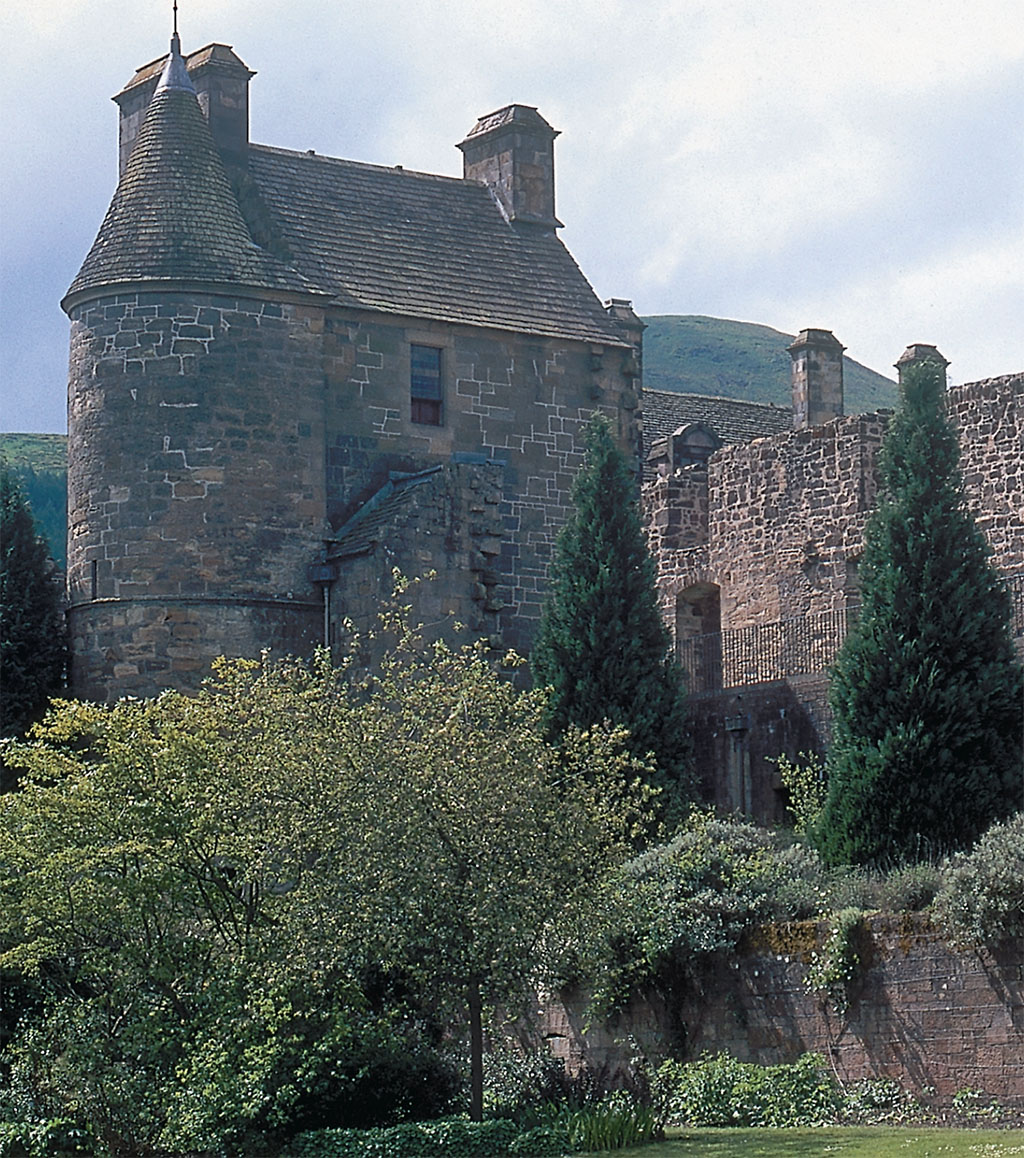
JIM HARGAN
[caption id="FifeKingdomofNooksandCrannies_img6" align="aligncenter" width="553"]

JIM HARGAN
For the most part, inland Fife is mildly attractive, an empty land of rolling hills covered in farms and meadows. Lanes wander about without much purpose, easy places to get lost despite the well-kept signposts of cast iron. Here we found Scotstarvit Tower. It’s a classic tower house, six stories tall, nearly windowless and L-shaped so that archers on the parapet could shoot at unwelcome guests at the front door. Despite its appearance, it’s not a castle, having no curtain walls or bailey; it was meant for protection against robbers rather than attacking armies.
The great sight of the interior is Falkland Palace and Royal Burgh, sitting in the lee of the paplike Hills of Lomond. James II of Scotland built it in the mid-15th century (on the site of an earlier Macduff fortress), and it officially remains a royal palace even though no monarch has visited it since Charles II in 1651. James and his successors built it as series of long, low halls filled with windows, an elegant blend of late Gothic with early Renaissance; its interior has been wonderfully restored. The kings of the Scots must have felt very safe here; there’s no apparent fortification save a grand, five-story gatehouse whose large windows spoil any military usefulness. The Royal Burgh, established to make it a bit easier to procure food and drink for the huge royal retinue, attaches itself to the palace, a robust village.
Bill Lessels, property manager for the National Trust of Scotland in this area, met us at Falkland. Bill delighted in showing off all of the palace’s finest corners, but his true love and pride was clearly its sister property, the village of Culross. “Are you planning to visit it?” he repeatedly asked, and I prevaricated; Culross was deep within the western district of Fife, an area unfortunate enough to have large coal seams and therefore populated with generic British Industrial Towns. Our lone sally into this district, to find a medieval abbey said to be hidden within a modern town center, was not successful. Nevertheless, Bill’s enthusiasm inspired us, and we scheduled our last full day for a visit to Culross.
Medieval Culross was a prosperous abbey town whose monks obtained their wealth by trading in salt, boiled from seawater using the strange, burnable black rocks found scattered about. By the 16th century, however, the easy coal was gone, and in 1575 the abbey sold its surface scratchings to a local merchant, George Bruce. Bruce invented new methods of deep mining with ventilation and drainage, creating the modern coal mining industry. At first he, too, used the coal to produce salt, but the coal soon became the more precious of the two, and Bruce started shipping coal.
[caption id="FifeKingdomofNooksandCrannies_img7" align="aligncenter" width="1024"]
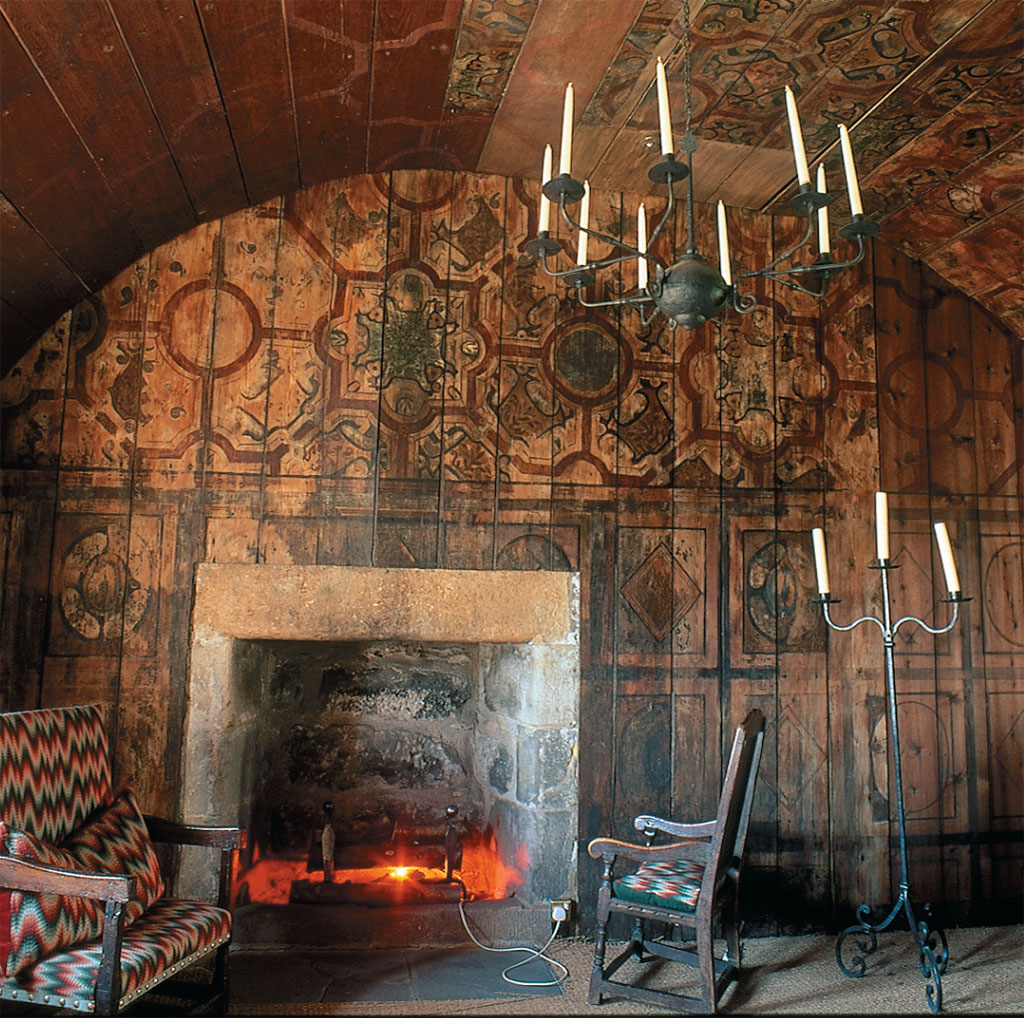
JIM HARGAN
[caption id="FifeKingdomofNooksandCrannies_img8" align="aligncenter" width="659"]

JIM HARGAN
[caption id="FifeKingdomofNooksandCrannies_img9" align="aligncenter" width="1024"]

JIM HARGAN
Culross boomed, the first town of the Industrial Revolution, and Bruce became one of the leading burgesses of Scotland, entertaining King James VI several times at his swank new mansion across from the harbor. By 1600, Bruce’s mine extended a mile under the Firth of Forth, with a shaft extending upward into the firth, protected by cofferdams. In 1625, however, a massive storm breached the dams and flooded the mines, ruining Bruce, who died a few months later.
It ruined Culross as well, and it, too, died. Modern Culross is made up almost entirely of the buildings constructed for Bruce’s 50-year coal boom, and nearly all of it is owned by the National Trust for Scotland—the world’s original coal town, perfectly preserved and beautifully restored. The town groups around Bruce’s mustard yellow wharfside mansion, known misleadingly as The Palace, a colorful statement of comfortable success. On the inside you’ll find the original wall paintings commissioned by Bruce in amazingly good shape; behind it a large terrace garden climbs a short cliff, planted in herbs, vegetables and flowers for clipping, as was the practice of practical burgesses. A statue in front commemorates the town’s most famous son, Thomas Cochrane, the heroic sea captain of the Napoleonic wars, reared in a graceful early Renaissance country home behind the town’s church. Culross affords hours of wandering, aided by the Trust’s excellent guidebook.
And the next morning we left Fife. On the way out, we stopped once more at Queensferry, just to admire the view from its quay. We had the time; we were, after all, less than a half dozen miles from the car rental, the train station and the airport. We could savor Fife for just a few extra minutes.





Comments